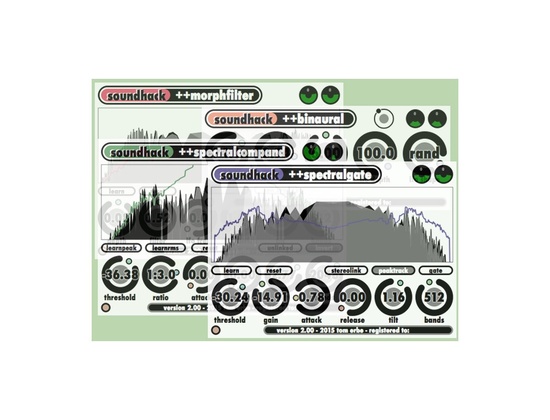
With the granular algorithm, you can also control the grain size and 'shimmer'. Switching between the two can really help you decide which suits the material best.

Once again the sound is segmented and then layered, and, again, two methods are used: the phase vocoder and granular synthesis algorithms. This is a multi‑layered, real‑time stretcher. This effect varies from a harmoniser to a weird harmonic auto‑tuner. The pitch‑shifted sound is then compared to this list and the frequencies that lie between the highest and lowest notes are shifted to the nearest harmonic of the MIDI notes being played. When you select 'MIDI vocoder', the plug‑in uses an incoming MIDI note to create a list of harmonics, the number of which is selected by the 'MIDI harmonics' control. The other method uses an inverse FFT (Fast Fourier Transform) algorithm to produce a similar result. This harmonic gating can, at extreme settings, reduce the sound to just a small number of sine waves, with interesting results. The more bands, the greater the CPU drain, so a partial gate control is added, which removes harmonics below a particular threshold level. The first uses a bank of sine‑wave oscillators, with each block of samples controlling one oscillator's amplitude and frequency. In its 'sensible' setting, with bands set between 10 and pitch‑shifts less than an octave, it behaves like a normal high‑quality processor, although it does have the choice of two modes that give slightly different sounds and - be warned - have very different CPU needs. Able to shift up or down by up to four octaves, it has the ability to transform sound beyond recognition. The first plug‑in of the bundle is +pitchsift, a classic phase‑vocoder‑based pitch‑shifter. A world of more aggressive sounds then opens up. Setting the rate lower, meanwhile, will allow multiple harmonics to enter individual bands and will increase the amount of cross‑modulation and frequency distortion.


This is, as Erbe points out, great for making ambient washes and drone sounds. But where's the fun in that? Increasing the band rate above 2048 will give you finer pitch resolution but at the cost of smearing the sound, reducing the resolution of the time transients. At 44100Hz, the sweet spot is between 10 bands, giving you a smooth frequency response and a reasonably fast transient response in other words, conventional pitch‑shifting and time‑stretching with relatively few artifacts. The granular synthesis program also divides the sound into small segments or grains, but doesn't divide it by frequency.Įach plug‑in has a 'bands' control that governs this ratio. The number of frequency bands and the number of samples in each block are linked, so there is a constant trade‑off between frequency response and transient (time) response. The phase vocoder works by sampling the incoming signal and dividing it into blocks each block is, in turn, divided into different frequency bands.

This is a collection of plug‑ins that use the Soundhack phase vocoder and granular synthesis algorithms to stretch time, shift pitch and distort phase. PvocativeĮrbe's new collection is the Pvoc Kit. The Soundhack plug‑ins are available for Mac, in VST, AU and RTAS versions, and as VST plug‑ins for Windows. So far, there have been three bundles, all containing plug‑ins based around similar themes: the Delay Trio, for example, contains a delay, a pitch delay and the enigmatically titled Bubbler. Since 2000, Erbe has also been spinning off the technology behind Soundhack in various plug‑ins. The original Soundhack program has collected many fans, from Trent Reznor to Ry Cooder, and its collection of filters and spectral manipulation techniques has been used on films such as The Matrix and The City Of Lost Children. Tom Erbe's Soundhack processors have been around since 1991, and are described on the company's web site as "Essential tools for adventurous musicians and sound designers”. Soundhack's powerful algorithms can provide high‑quality pitch‑shifting - or sonic mayhem!


 0 kommentar(er)
0 kommentar(er)
